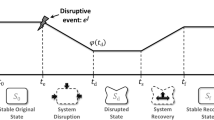Abstract
We consider the problem faced by managers of critical civil interdependent infrastructure systems of restoring essential public services after a non-routine event causes disruptions to these services. In order to restore the services, we must determine the set of components (or tasks) that will be temporarily installed or repaired, assign these tasks to work groups, and then determine the schedule of each work group to complete the tasks assigned to it. These restoration planning and scheduling decisions are often undertaken in an independent, sequential manner. We provide mathematical models and optimization algorithms that integrate the restoration and planning decisions and specifically account for the interdependencies between the infrastructure systems. The objective function of this problem provides a measure of how well the services are being restored over the horizon of the restoration plan, rather than just focusing on the performance of the systems after all restoration efforts are complete. We test our methods on realistic data representing infrastructure systems in New York City. Our computational results demonstrate that we can provide integrated restoration and scheduling plans of high quality with limited computational resources. We also discuss the benefits of integrating the restoration and scheduling decisions.
Similar content being viewed by others
References
Ahuja, R. K., Magnanti, T. L., & Orlin, J. B. (1993). Network flows: Theory, algorithms, and applications. Englewood Cliffs: Prentice-Hall.
Dolan, E. D., Fourer, R., Moré, J. J., & Munson, T. S. (2002). Optimization on the NEOS server. SIAM News, 35(6), 8–9.
Gong, J., Lee, E. E., Mitchell, J. E., & Wallace, W. A. (2009). Logic-based multi-objective optimization for restoration planning. In W. Chaovalitwongse, K. C. Furman, & P. M. Pardalos (Eds.), Optimization and logistics challenges in the enterprise. Berlin: Springer. Chap. 11.
Lee, E. E. (2006). Assessing vulnerability and managing disruptions to interdependent infrastructure systems: A network flows approach. PhD thesis, Rensselaer Polytechnic Institute, Troy, NY.
Lee, E. E., Mitchell, J. E., & Wallace, W. A. (2007). Restoration of services in interdependent infrastructure systems: A network flows approach. IEEE Transactions on Systems, Man, and Cybernetics, Part C: Applications and Reviews, 37(6), 1303–1317.
Lee, E. E., Mitchell, J. E., & Wallace, W. A. (2009). Network flow approaches for analyzing and managing disruptions to interdependent infrastructure systems. In J. G. Voeller (Ed.), Wiley handbook of science and technology for Homeland Security (Vol. 2, pp. 1419–1428). New York: Wiley.
Lougee-Heimer, R. (2003). The common optimization interface for operations research. IBM Journal of Research and Development, 47(1), 57–66.
Mendonca, D., & Wallace, W. A. (2006). Impacts of the 2001 World Trade Center attack on New York City critical infrastructures. Journal of Infrastructure Systems, 12(4), 260–270.
O’Rourke, T. D. (2007). Critical infrastructure interdependencies, and resilience. The Bridge: National Academy of Engineering, 37(1), 22–29.
Pinedo, M. L. (2008). Scheduling: Theory, algorithms, and systems. New York: Springer.
Rinaldi, S. M., Peerenboom, J. P., & Kelly, T. K. (2001). Identifying, understanding, and analyzing critical infrastructure interdependencies. IEEE Control Systems Magazine, 21(6), 11–25.
Savelsbergh, M. W. P., Uma, R. N., & Wein, J. (2005). An experimental study of LP-based approximation algorithms for scheduling problems. INFORMS Journal on Computing, 17, 123–136.
Sousa, J. P., & Wolsey, L. A. (1992). A time indexed formulation of non-preemptive single machine scheduling problems. Mathematical Programming, 54(3), 353–367.
Wallace, W. A., Mendonca, D., Lee, E., Mitchell, J. E., & Chow, J. (2003). Managing disruptions to critical interdependent infrastructures in the context of the 2001 World Trade Center attack. In Beyond September 11th: An account of post-disaster research (pp. 165–198).
Author information
Authors and Affiliations
Corresponding author
Additional information
The views and conclusions contained in this document are those of the authors and should not be interpreted as necessarily representing the official policies, either expressed or implied, of the US Department of Homeland Security.
Rights and permissions
About this article
Cite this article
Cavdaroglu, B., Hammel, E., Mitchell, J.E. et al. Integrating restoration and scheduling decisions for disrupted interdependent infrastructure systems. Ann Oper Res 203, 279–294 (2013). https://doi.org/10.1007/s10479-011-0959-3
Published:
Issue Date:
DOI: https://doi.org/10.1007/s10479-011-0959-3




